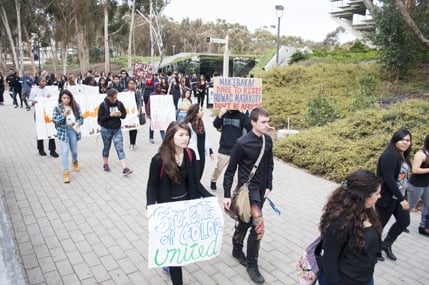Campus groups mobilized to draw attention to the difference in Calif. spending on prisons and education.
Over 100 black-clad students mobilized for their “March 4 Education N’ De-Incarceration” at the Silent Tree on Tuesday. The 2014 Student Affirmative Action Committee Chair Ernesto Reyes led the march, which primarily sought to raise awareness for California’s disproportionate spending on the “prison-industrial complex” at the state education system’s expense.
The SAAC is a committee of eight UCSD organizations that advises several administrative offices, dedicating itself to “fighting ignorance, addressing the issues confronting underrepresented students and promoting cross-cultural awareness and communication” since 1975, according to the movement’s Facebook page. It claims that California spends over $48,000 per inmate every year, as opposed to $7,463 per University of California or California State University student.
SAAC also believes that public education is increasingly difficult for students, especially racial minorities, to obtain, thus perpetuating inequal
ity in the state. In a 2013–14 budget report, Gov. Jerry Brown proposed a total budget of over $9 billion for inmates in the California Department of Corrections and Rehabilitation, while about $12.4 billion would be allocated for higher education.
The appropriately named March 4 Education is an annual event that has been held across multiple UC and CSU campuses since 2010. At UCSD, the event was organized by a coalition of groups, including the A.S. External Affairs Office, as part of the University of California Student Association’s larger IGNITE campaign.
Reyes, who has been involved with social activism for four years, explained that the prison-industrial complex facilitates domestic incarceration of underrepresented communities and that the issue affects everyone who feels it is important to promote affordable education.
“It is a day of action to try to bring to light the lack of investment in education,” Reyes said. “We see that prisons have taken a lot of the funds that education has usually had, so we’re here to come together in solidarity with those who have been excluded from higher education and those who are continually marginalized and oppressed by the prison-industrial complex.”
Eden Berdugo, an External Affairs campus organizing director, agreed that it’s a large problem for those who are in some way, shape or form tied to the prison-industrial complex, especially people of color.
“Many people don’t have the same opportunities, and there are a lot of broken systems,” Berdugo said. “I think we could start to see changes if we funneled more money into lower education. We all have a responsibility towards it because we are invested in it. We also forget a lot of times that students are accepted, but it’s really an uphill battle for them to graduate.”
Starting from the Silent Tree in front of Geisel Library, the protesters moved down Library Walk, through the Chancellor’s Complex and ended at the Triton Statue at Price Center. Throughout the march, students were given the chance to lead chants and present their personal testimonials to the group.
“Being students can be hard, but we stand together across many different communities and struggles,” Reyes said. “We are not simply numbers to be funneled through. Why can’t I find a job after the university promised me so much? March 4 isn’t just a single day event. Make our university work for us, not the other way around.”
Other participants echoed his view, emphasizing the importance of fighting for the marginalized population, declaring, “When we chant ‘Our University,’ we have to mean it.” They expressed discontent and disbelief at the various negative effects of a large prison-industrial complex on the student body.
A.S. President Andy Buselt attended the event as well. He felt that the problems with university privatization and school funding “didn’t add up” but had high hopes for bringing about a more socially just university. A.S. Council planned to consider the Students Against Mass Incarceration’s divestment bill, which criticizes UCSD’s financial holdings with companies allegedly connected to state and private prisons, the following day.
“It’s more of a symbolic measure, but once one UC divests, then others follow, and it sets a precedent,” Berdugo said. “It puts more pressure on the regents.”
Reyes added that he hoped to work with the administration to divest from the complex as UCLA and UC Irvine have done but at a systemwide scale.









kathleen • May 4, 2014 at 2:54 pm
Time to stand up and demand more investment into education for our children and future residents of the state of california.Less money towards prison populations.